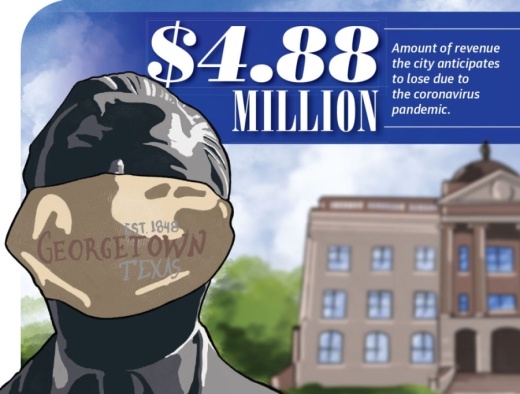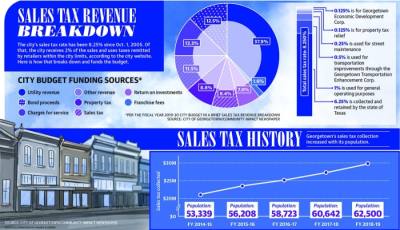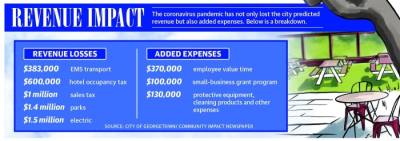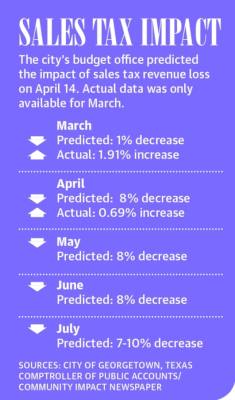To Have and To Hold, a custom gift and bridal store, was open for 37 days before it was forced to completely shut down due to the coronavirus pandemic.
The business opened one block west of the Georgetown Square Feb. 1 after relocating from Round Rock.
Opening on the Square was “a dream come true” for owner Dixie Doss, she said.
“To see the first 30 days of this business just fly was incredible,” Doss said.
“Being on top of the world and crashing down was just heartbreaking.”
This story is just one of many about businesses struggling to adapt and survive in a Pandemic.
Doss said half of her business consists of custom gifts, which she managed to keep up as much as she could during the closure through door-to-door delivery, partnering with other local small businesses and selling items through social media channels, such as Facebook and Instagram.
But the second half of her business relies on the wedding industry, which also took a hit as capacity restrictions forced many weddings to be rescheduled or canceled.
Doss sells wedding invitations, save-the-dates, napkins, cake toppers, bridal party gifts and more. She said that part of her business came to a complete standstill.
Doss, who had one part-time employee, is now operating the business completely on her own. She said she also continues to deliver door-to-door, an adaptation that came from the pandemic that she said she will likely keep. She added that she will do whatever it takes to keep her business alive.
“For small businesses, if we don’t have people that are supporting us, you won’t have us. That small boutique store, that small business on the Square will be nonexistent,” Doss said. “And at the end of the day, [small businesses] are the backbone of the community.”
Julie Bennett, who makes money selling handmade upcycled vintage clothing at rodeos, junk shows and livestock shows across the country through her business Yipiokya, said she lost her main source of income when those events were canceled.
Bennett said she has also moved to selling merchandise online to help make ends meet.
“Every single day, I’m making something new and putting it online, and some of it sells, [and] some of it doesn’t. But it’s enabled me to kind of keep my head above water and get my bills paid and stay afloat, stay alive,” Bennett said.
Alycia Tandy, owner of Do Yourself A Flavor, decided to close her business altogether. The catering service had been serving Georgetown since 1994.
When the pandemic hit, Tandy said she had absolutely no revenue stream, as the events she catered—usually church events, nonprofit events, golf tournaments and events hosted in public buildings—were all canceled.
She used to average 30-40 events a month, with May being one of her busiest, she said. That dropped to zero when the pandemic hit.
“I just took it as a sign that it was time to do something else,” Tandy said.
Tandy had four part-time employees who she said are now looking for another way to supplement their income.
“It’s just so crazy that all these years nothing has ever stopped [my business],” Tandy said. “And something like this just put it dead in its tracks. It’s just—it’s hard to imagine. And no matter which way I’ve tried to bring it back up, it just doesn’t happen.”
Cost to the city
When local businesses are not making sales, it also has a ripple effect into city funding. About 8.4% of the city’s general fund comes from sales tax revenue, according to the city’s website.
Leigh Wallace, the city’s director of finance, projects the city will lose 3% or about $1 million in sales tax revenue alone throughout the rest of fiscal year 2019-20 due to the pandemic. Overall, the city anticipates losing $4.88 million in revenue through FY 2019-20, she said. The fiscal year ends Sept. 30.
“On the revenue side, sales tax will be one of our biggest impacts,” Wallace said.
Sales tax, as well as the other revenue streams, go directly to supporting city services, such as police and fire departments, emergency management, parks and more, Wallace said. Wallace said at the moment she only has March data but anticipates April to be the city’s worst month this fiscal year in revenue collection.
The city also anticipates about $600,000 less in hotel tax revenue, which helps support the city’s visitor’s center and events such as the Red Poppy Festival, Wallace said.
Emergency, parks and electric utility services will all likely see a decrease in revenue, impacting the city’s budget, she added.
In turn, the city has also added an estimated $600,000 in expenses to help combat the virus. This includes costs for personal protective equipment, higher-grade cleaning products, more frequent cleanings and the $100,000 grant program the city entered with the Georgetown Chamber of Commerce to help support local small businesses.
The amount also includes $370,000 for employee time, which would have been paid anyway, but they were pulled into coronavirus-specific tasks, Wallace said. She said the city is keeping track of this to hopefully receive state or federal reimbursements.
However, Wallace said the city is seeing the increase in development revenue offset some of the losses.
“We have not seen development slow down at all. It is still going at a really steady fast clip,” Wallace said.
And while the city has seen a decrease in sales tax, March results were not as low as projected.
In a May 6 report by the Texas comptroller of public accounts, Georgetown saw a 1.91% increase in sales tax in March year over year. The city initially projected a 1% loss, according to an April 14 City Council presentation.
However, Wallace said she believes the city will see its greatest sales tax hit from the pandemic in April while the city was shut down for an entire month rather than the two weeks in March.
In April, the city saw a 0.69% increase in sales tax revenue, despite projecting an 8% decrease in revenue. The city also projected an 8% decrease in sales tax revenue in May and June and a 7%-10% decrease in July, August and September, the presentation said.
“Because this is not a typical disaster or typical economic downturn, ... I don’t know if we really could have accurately projected what would happen when we hadn’t seen this type of disaster,” Wallace said.
Unemployment grows
The closing of businesses led to a decrease in sales and ultimately impacted unemployment in the city.
The county issued stay-at-home orders March 24, which ended at 11:59 p.m. April 30. But even as industries begin to open with limited capacity, unemployment remains an issue.
While the city was closed, the Texas Workforce Commission tracked 4,605 filed unemployment claims in Georgetown’s three ZIP codes—78626, 78628 and 78633—between March 18 and May 16. This amounts to 11.83% of the city’s 38,922 working population ages 16-64 who worked prior to the pandemic and filed for unemployment, according to 2018 census five-year estimated data.
Williamson County saw 34,456 unemployment claims filed between March 18 and May 16, or 11.48% of the county’s 300,059 working population, data shows.
Georgetown women were also more likely to file claims than men: 2,645 Georgetown women filed for unemployment benefits, and 1,960 men filed, data shows.
Francisco Gomez, media and public relations specialist with the TWC, said Texas is reporting the highest number of claims it has ever seen. He said since the week ending May 16, two months since businesses began to close, the TWC has paid out $8.7 billion in unemployment benefits using state and federal funds to Texas residents.
This includes individuals who are no longer working or have reduced hours, he said.
Gomez said on average, a claim is processed in 21 days from the time people apply and become eligible. For some it may be quicker, and for others it may take a little more time, he added.
Georgetown Chamber of Commerce President Jim Johnson said while being closed for upward of 60 days for many businesses will make it very difficult for businesses to reopen or to operate sooner at their previous style of business, he is optimistic.
“On a positive note, businesses are going to learn, in some ways, more efficient ways to operate using technology,” Johnson said. “I’m also optimistic that businesses when they reopen have had time to streamline and also embrace technology so that they can be a more efficient, and hopefully more profitable, business.”









